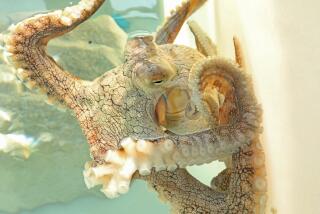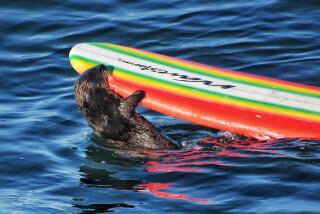Sea otters were hunted to near-extinction. Can they be reintroduced to former habitat?

Hunted for centuries for their pelts, sea otters had dwindled to near-extinction by the 1910s, leaving a population of about 1,000 worldwide and only about 50 in California, in small pockets on the Central Coast and Southern California’s Channel Islands.
With conservation efforts, California’s sea otter population has grown to about 3,000, still limited to the Central Coast, according to the Monterey Bay Aquarium.
Now, an idea being considered by the federal government could see the otters, which are listed as threatened under the Endangered Species Act, reintroduced to habitats in Northern California and Oregon.
The U.S. Fish and Wildlife Service recently completed a feasibility study for reintroducing the otters to their former habitats, which would serve two purposes: restoration of the species and “restoration of ecosystem function.”
The plan would involve introducing a mix of captured and surrogate-raised sea otters to some of the areas, followed by more than a decade of study.
Changes in work-life balance, remote work and more people quitting their jobs are driving greater numbers of residents out of the Golden State, a new report shows.
Over a 14-year period, the project could cost between $26 million and $43 million.
“As a keystone species, sea otters play a fundamental role in the ecological health of nearshore ecosystems,” wildlife officials said in a release Wednesday. “Sea otters eat sea urchins and other marine grazers, which helps keep kelp forests and seagrass beds in balance. Their presence in the ocean enhances biodiversity, increases carbon sequestration by kelp and seagrass, and makes the ecosystem more resilient to the effects of climate change.”
And aside from the ecological benefits the otters would provide, the sight of the fluffy sea mammals floating on their backs and cracking shells on their bellies could be a draw for tourists.
“Any reintroduced sea otter population, if visible or otherwise accessible to the public, is expected to enhance local businesses connected to ecotourism,” the Fish and Wildlife Service said in its report.
San Francisco declared a state of emergency for monkeypox as some have called for a more urgent response, but so far neither California nor L.A. County has done so.
According to the study, which wildlife officials noted is “the first step in any reintroduction effort” but is not an official proposal, bringing the species back to areas along the West Coast is “feasible” but would face multiple obstacles.
No specific reintroduction sites have been identified, the wildlife service said, and more studies would need to be done on the species’ impact on specific areas and industries.
“The shellfishing community in particular (who fish for urchin and clams) has expressed concerns about a potential reintroduction,” the service said. “We are exploring mechanisms to offset financial impacts that could be incorporated into any potential reintroduction proposals.”
The Fish and Wildlife Service recommended that more research be done specifically regarding potential sites and the socioeconomic effects of otter reintroduction.
More to Read
Sign up for Essential California
The most important California stories and recommendations in your inbox every morning.
You may occasionally receive promotional content from the Los Angeles Times.













